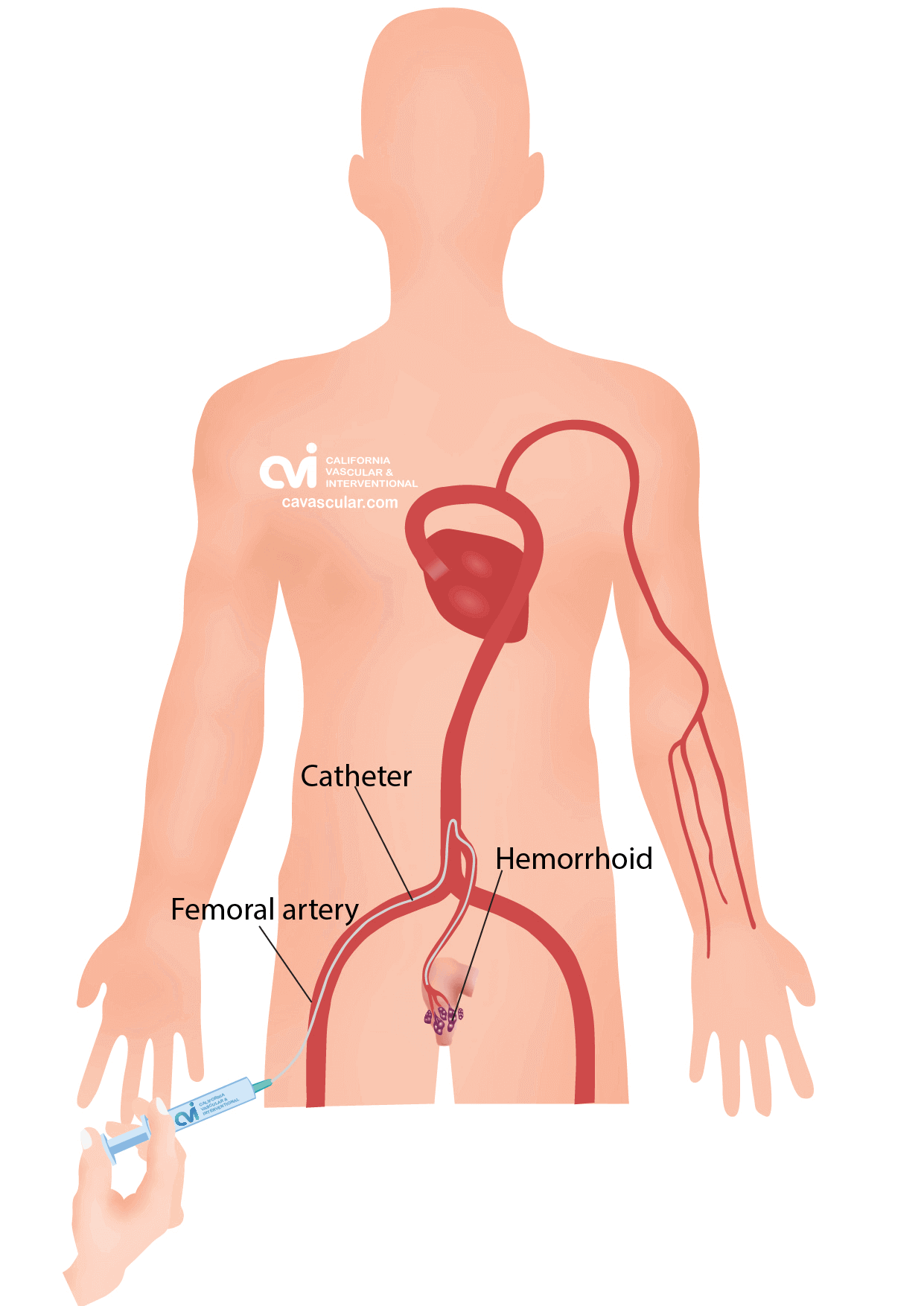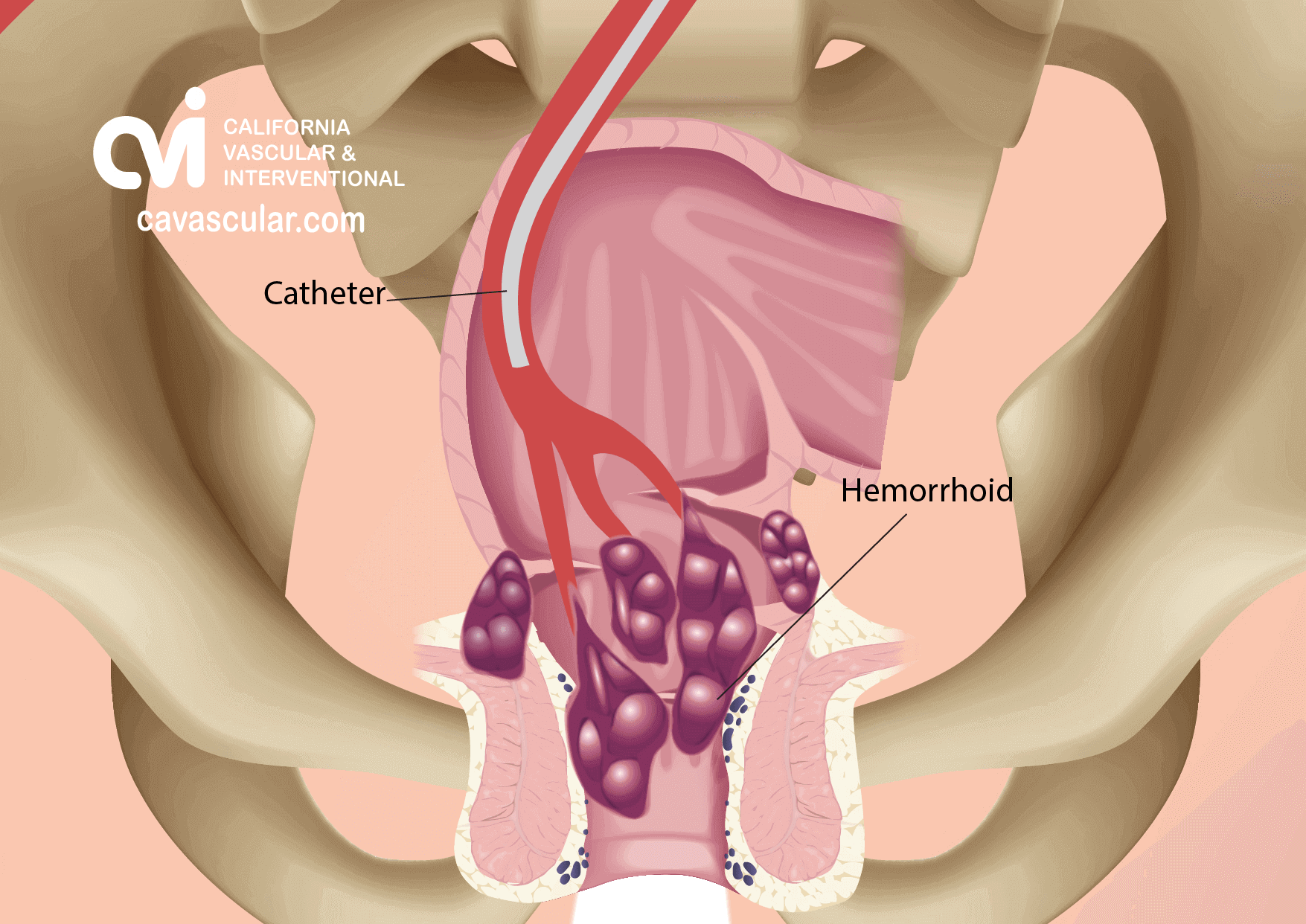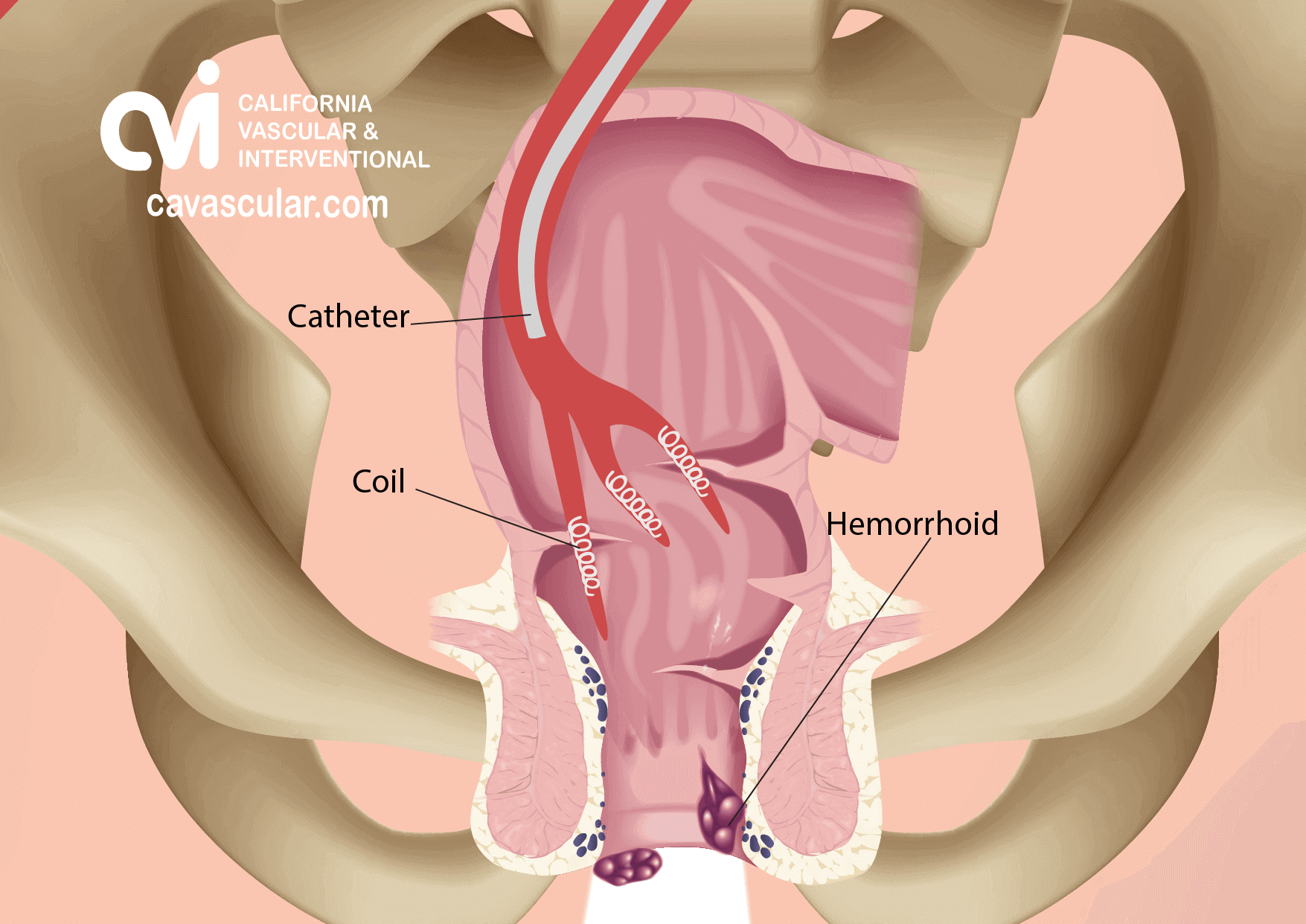
Virtual remote appointments are available. Contact us for a video telehealth evaluation.

All appointments conducted by our Board Certified doctor and not assistants or non-physician providers.
Hemorrhoid Embolization
Hemorrhoids are one of the most common problems of the anus/rectum (the anorectal region).1,2 They affect over 4.4% of the world population – which amounts to nearly 340 million people.3
Technically speaking, hemorrhoids are outgrowths of the anal mucosa, protruding from the rectal wall.7 In simpler terms, they are swollen veins in the anus/rectum. These outgrowths drastically decrease a patient’s quality of life. Indeed, the morbidity caused by hemorrhoids takes a massive toll on the patient’s physical and mental health as well as social behavior.3 It also exerts a substantial impact on the economy by causing a huge loss in productivity.3
Hemorrhoid Types
Based on their location, there can be two main types of hemorrhoids: internal or external.3,4 Before we learn more about hemorrhoid types, it is important to understand what the dentate line is. This is a line located a third of the way up the anal canal, dividing it into two distinct areas.
External hemorrhoids are present below the dentate line.3,4 This is an area that has a large number of nerves in the skin and muscle tissues – which means that these hemorrhoids are bound to be more painful.4 Meanwhile, internal hemorrhoids lie above the dentate line.3,4 This section of the anal canal has nerves only in the more internal tissue layers (also known as visceral innervation).4 Therefore, internal hemorrhoids are associated with painless bleeding during defecation, while external hemorrhoids present themselves with itching and bleeding.4
It is crucial to know that internal hemorrhoids can sometimes fall out of the anus (something known as prolapse).5 Depending on the degree of prolapse, doctors can further categorize internal hemorrhoids into different grades (I to IV).6
Hemorrhoid Diagnosis
Hemorrhoids are commonly diagnosed using visual and/or digital (that is, using fingers) inspection by a doctor.5 External hemorrhoids are easier to diagnose, with a thorough visual inspection of the anal area.5 During this inspection, the doctor looks for signs of swelling, lumps, blood clots, leakage, skin irritation and anal fissures (tears).5
Internal hemorrhoids are diagnosed through digital rectal inspection, during which the doctor assesses the presence of blood, lumps or tenderness.5 More sophisticated techniques, like anoscopy and rigid proctosigmoidoscopy, further help visualize the internal layers of the anus and the rectum.5 Importantly, while these are both invasive techniques, they do not typically require anesthesia.5
Hemorrhoid Treatment Options
Hemorrhoid treatment typically begins with management strategies. These involve the use of stool softeners and an increase in the intake of dietary fiber and water.6 Other methods include the use of ointments, including those with nitroglycerine, to be applied at the site of the hemorrhoids.6 Infrared photocoagulation and bipolar diathermy are other frequently used treatment methods.2
In patients for whom these initial strategies do not work, the go-to treatment option, for internal hemorrhoids (grades I to III), is rubber band ligation.6 The last resort is surgical intervention, also known as excisional hemorrhoidectomy.6 Surgery is also used to treat external hemorrhoids that are filled with blood clots (called thrombosed hemorrhoids).6
However, surgical methods, necessary in around 10% of patients, are fairly painful and require a longer recovery time.1,6 Less invasive methods are, thus, more comfortable for the patient. One such method is hemorrhoidal artery ligation, which is commonly used to treat grade II and III internal hemorrhoids.2,6 Recently, another technique has come to fore to treat hemorrhoids in a less invasive manner. This method, developed by an Interventional Radiologist at Aix-Marseille University (France), is called hemorrhoid embolization, or the ‘Emborrhoid Technique’.1,2,7
Hemorrhoid Embolization: Procedure
Embolization is an outpatient non-surgical procedure with minimal downtime. The procedure is done in an outpatient state of the art center where our interventional radiologist performs the fibroid treatment through a tiny tube called a catheter. This procedure can be performed by either placing the catheter in an artery at the top of the leg (called a femoral approach) or by placing it into an artery in the lower arm (called a radial approach).
Embolization can be performed as outpatient with only local anesthesia and does not involve any scopes or direct manipulation of the anorectal region.1,2 Embolization is the process of blocking a blood vessel to prevent blood flow to a part of the body. The reduced blood flow is what treats the hemorrhoids in this procedure.
The blood supply to internal hemorrhoids comes through the superior rectal arteries (SRAs), which branch from a larger blood vessel known as the inferior mesenteric artery.1 A tiny tube is inserted in this artery and a procedure called angiography is performed to visualize all the SRAs.1 Microcatheters (thin, micro-sized catheters) are then introduced in each SRA branch and the abnormal vessels are embolized (blocked) using tiny coils 2-3 mm in diameter.1 This entire process takes one to two hours.1

Hemorrhoid Embolization: Results
Hemorrhoid embolization is technically successful if the doctor can block all the abnormal vessels.1 Notably, doctors are able to achieve a 90-100% technical success rate in the procedure.1,2 This is a good sign for the feasibility of the technique.
The procedure is considered clinically successful if it is able to relieve patient symptoms and improve the quality of life.1 By this definition, the clinical success of the Emborrhoid Technique has ranged from 63% to 94% in various studies.7 Note that the embolizing microcoils may be accompanied by microspheres (tiny spherical particles) to achieve high clinical efficacy of up to 93%.7 However, improved clinical success may come at the cost of a lower rate of minor complications.7


Hemorrhoid Embolization: Recovery
This is an outpatient procedure with minimal downtime. Patients are discharged home usually 1-2 hours after the procedure. Reports estimate a 75% patient satisfaction rate.1 This high rate of satisfaction is understandable, given the short procedure time, absence of any complications, and quick recovery time.1 In fact, patients can return home on the day of the treatment itself.1
Hemorrhoid Embolization: Ideal Candidate
An ideal candidate for embolization is someone that has internal hemorrhoids that has failed other treatments by their gastroenterologist.
Hemorrhoid Embolization: Cost
The procedure is typically covered by most insurance companies. Prior to the procedure you would require a thorough evaluation of your symptoms and medical records by our interventional radiologist to make sure you meet medical necessity for coverage.
Hemorrhoid Embolization: Advantages
Hemorrhoid embolization offers several advantages over other treatment options. There are no surgical risks or alteration of the rectum. The patient’s ability to control anal movements (also known as continence) remains unaffected by the procedure.1 This technique does not create any rectal wounds.1 The anorectal region does not require any local care after the procedure. Most importantly, it is the least invasive surgical technique for hemorrhoid treatment, on par with hemorrhoidal artery ligation.1
Overall, hemorrhoid embolization is a revolutionary new hemorrhoid treatment that is highly successful and feasible for both doctors and patients. Its many advantages set it apart from conventional treatment options. More clinical trials will help to better assess the efficacy of this technique and ultimately take it to the masses.
Appointments are available via an online video telehealth platform or in person at one of the offices in Los Angeles, Orange County or San Diego, depending on the doctor’s availability. Contact Us Today. Why should you choose us? Read here.
References
- Vidal, V. Hemorrhoid Embolization: Does It Last? Endovascular Today. 2018; 17(4): 82-84.
- Rebonato A, Maiettini D, Patriti A, et al. Hemorrhoids Embolization: State of the Art and Future Directions. Journal of Clinical Medicine. 2021; 10(16): 3537-3544.
- Kibret AA, Oumer M, Moges, AM. Prevalence and associated factors of hemorrhoids among adult patients visiting the surgical outpatient department in the University of Gondar Comprehensive Specialized Hospital, Northwest Ethiopia. Plos One. 2021; 16(4): 1-11.
- Nauman K, Samra NS. Anatomy, Abdomen and Pelvis, Anal Triangle. StatPearls. 2020.
- National Institute of Diabetes and Digestive and Kidney Diseases. Diagnosis of Hemorrhoids. NIDDK. 2016; URL: https://www.niddk.nih.gov/health-information/digestive-diseases/hemorrhoids/diagnosis.
- Mott T, Latimer K, Edwards C. Hemorrhoids: diagnosis and treatment options. American Family Physician. 2018; 97(3): 172-179.
- Vidal V, Tradi F. Hemorrhoid artery embolization: Outcome and results – literature review. European Conference on Embolotherapy. 2022; URL: https://www.etconference.org/programme/et-2022-sneak-peeks/haemorrhoid-artery-embolisation-outcome-and-results-literature-review/
The above information explains what is involved and the possible risks. It is not meant to be a substitute for informed discussion between you and your doctor, but can act as a starting point for such a discussion.
